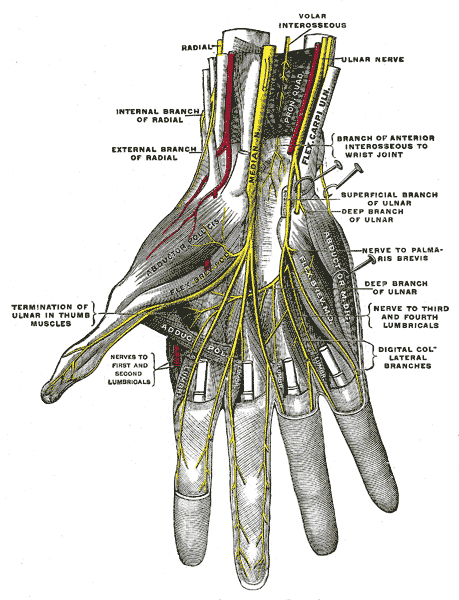[1]
Cho SH, Chung IH, Lee UY. Relationship between the ulnar nerve and the branches of the radial nerve to the medial head of the triceps brachii muscle. Clinical anatomy (New York, N.Y.). 2019 Jan:32(1):137-142. doi: 10.1002/ca.23207. Epub 2018 Dec 3
[PubMed PMID: 29770497]
[2]
Musso D, Klaastad Ø, Wilsgaard T, Ytrebø LM. Brachial plexus block of the posterior and the lateral cord using ropivacaine 7.5 mg/mL. Acta anaesthesiologica Scandinavica. 2019 Mar:63(3):389-395. doi: 10.1111/aas.13277. Epub 2018 Oct 18
[PubMed PMID: 30338518]
[3]
Zhu W, Zhou R, Chen L, Chen Y, Huang L, Xia Y, Papadimos TJ, Xu X. The ultrasound-guided selective nerve block in the upper arm: an approach of retaining the motor function in elbow. BMC anesthesiology. 2018 Oct 19:18(1):143. doi: 10.1186/s12871-018-0584-7. Epub 2018 Oct 19
[PubMed PMID: 30340524]
[4]
Fraher JP,Dockery P,O'Donoghue O,Riedewald B,O'Leary D, Initial motor axon outgrowth from the developing central nervous system. Journal of anatomy. 2007 Nov
[PubMed PMID: 17850285]
[6]
Noland SS, Bishop AT, Spinner RJ, Shin AY. Adult Traumatic Brachial Plexus Injuries. The Journal of the American Academy of Orthopaedic Surgeons. 2019 Oct 1:27(19):705-716. doi: 10.5435/JAAOS-D-18-00433. Epub
[PubMed PMID: 30707114]
[7]
Puffer RC, Bishop AT, Spinner RJ, Shin AY. Bilateral Brachial Plexus Injury After MiraDry Procedure for Axillary Hyperhidrosis. World neurosurgery. 2019 Apr:124():370-372. doi: 10.1016/j.wneu.2019.01.093. Epub 2019 Jan 29
[PubMed PMID: 30703585]
Level 3 (low-level) evidence
[8]
Parra S,Orenga JV,Ghinea AD,Estarelles MJ,Masoliver A,Barreda I,Puertas FJ, Neurophysiological study of the radial nerve variant in the innervation of the dorsomedial surface of the hand. Muscle
[PubMed PMID: 29896804]
[9]
Babaei-Ghazani A, Roomizadeh P, Sanaei G, Najarzadeh-Mehdikhani S, Habibi K, Nikmanzar S, Kheyrollah Y. Ultrasonographic reference values for the deep branch of the radial nerve at the arcade of Frohse. Journal of ultrasound. 2018 Sep:21(3):225-231. doi: 10.1007/s40477-018-0303-8. Epub 2018 Jun 16
[PubMed PMID: 29909505]
[10]
Bunnell AE, Kao DS. Planning Interventions to Treat Brachial Plexopathies. Physical medicine and rehabilitation clinics of North America. 2018 Nov:29(4):689-700. doi: 10.1016/j.pmr.2018.06.005. Epub 2018 Sep 5
[PubMed PMID: 30293624]
[11]
Latef TJ, Bilal M, Vetter M, Iwanaga J, Oskouian RJ, Tubbs RS. Injury of the Radial Nerve in the Arm: A Review. Cureus. 2018 Feb 16:10(2):e2199. doi: 10.7759/cureus.2199. Epub 2018 Feb 16
[PubMed PMID: 29666777]
[12]
Akhavan-Sigari R,Mielke D,Farhadi A,Rohde V, Study of Radial Nerve Injury Caused By Gunshot Wounds and Explosive Injuries among Iraqi Soldiers. Open access Macedonian journal of medical sciences. 2018 Sep 25
[PubMed PMID: 30337976]
Level 2 (mid-level) evidence
[13]
Heiling B, Waschke A, Ceanga M, Grimm A, Witte OW, Axer H. Not your average Saturday night palsy-High resolution nerve ultrasound resolves rare cause of wrist drop. Clinical neurology and neurosurgery. 2018 Sep:172():160-161. doi: 10.1016/j.clineuro.2018.07.006. Epub 2018 Jul 9
[PubMed PMID: 30015054]
[14]
Ehrlich W, Dellon AL, Mackinnon SE. Classical article: Cheiralgia paresthetica (entrapment of the radial nerve). A translation in condensed form of Robert Wartenberg's original article published in 1932. The Journal of hand surgery. 1986 Mar:11(2):196-9
[PubMed PMID: 3514740]
[15]
Sukegawa K, Kuniyoshi K, Suzuki T, Matsuura Y, Onuma K, Kenmoku T, Takaso M. Effects of the Elbow Flexion Angle on the Radial Nerve Location around the Humerus: A Cadaver Study for Safe Installation of a Hinged External Fixator. The journal of hand surgery Asian-Pacific volume. 2018 Sep:23(3):388-394. doi: 10.1142/S242483551850042X. Epub
[PubMed PMID: 30282553]
[16]
Alam M, Haq AU. Wrist drop and focal seizures in a 60-year-old man. Postgraduate medical journal. 2018 Dec:94(1118):729. doi: 10.1136/postgradmedj-2018-136115. Epub 2018 Oct 19
[PubMed PMID: 30341228]


